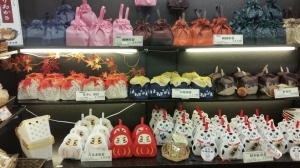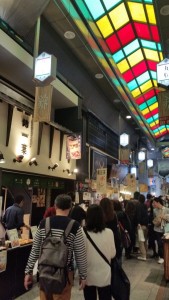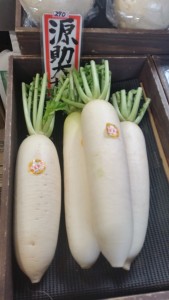Kyoto’s reign as Japan’s capital for over a thousand years (794-1868) seeded a rich culture that still blooms today. Haute keiseki ryori multi-course cuisine, polished geisha, refined tea ceremonies, fine textiles and ceramics—the legacy of wealthy courts competing with each other through ritualised acts of elegance and sophistication. Catching this fading luminescence is the new blood sport.
In 2015, Japan had a record 19.73 million tourists, 47.3% up from 2014. The government weakened the yen in 2013 to lift the stagnant economy. A foreign investment boom didn’t follow but tourist hordes did, boosted further by relaxed duty-free concessions and Visit Japan campaigns.
“Bakugai” meaning “explosive shopping sprees by Chinese tourists” was a top 2015 Japanese buzzword. The most coveted products? Made in Japan deluxe rice cookers and high-tech toilet seats.
I still recommend braving 400-year-old Nishiki Market—390 metres of food and kitchen ware shops in a narrow arcade. Go early—it opens at 9 a.m. One shopkeeper told us it’s too pricey for most locals now, but it draws dedicated gourmets and chefs.

Typically Japanese, it’s immaculately scrubbed with meticulous displays as delectable as the goods. Many of the roughly 130 shops have been run by the same family for generations.


Sake from Tsunoki, a shop more than 200-years-old. They also sell an unusual sparkling cloudy sake, nigorisake.
Packed with pristine produce, the market is strangely scentless, bar the astringent aroma of tsukemono (pickled vegetables). In Australia, these are usually measly, factory-made ginger slices, dyed lurid pink, served with sushi. Here, there’s an artisanal, kaleidoscopic bounty. Eaten at breakfast, lunch and dinner, they are as treasured as rice.
Honoured in religious rites since ancient times, rice commands reverence. Over 500 varieties are grown in Japan. A luxury in the 11th century, eaten as rice balls at royal picnics; today, it’s the core of most meals. This rice is displayed by increasing quality and price.
Yamadashiya specialises in roasted hōjicha tea.
Sawawa offers green tea desserts.
Hand ground sesame seeds at Gomafukudo.
Roasted chestnuts at Kyotanba.
Massive daikon radish is a much-loved vegetable but “daikon-ashi” (legs of a daikon) is a terrible insult to women!
Japanese knives have gained fans around the world. Internationally renowned chefs visit Aritsugu, open since 1560 and a former sword supplier to the Imperial Palace. Demand for swords fell during the peaceful Edo period (1603-1868) and from the 1860s as samurai were outlawed, so sword makers turned to handcrafting knives.

Alternately enticed and repelled by the barrage of familiar and alien, I balked at some of the more exotic delicacies.
Fuka is over 300 years old and sells dense, gelatinous fu, wheat gluten mixed with rice flour. Fresh namafu can be simmered, fried or grilled. Classic flavours like pumpkin or sesame sit with the newer bacon, basil or cheese.
There’s copious seafood—beloved in this nation of islands. Buddhism’s influence and largely mountainous terrain unsuitable for raising livestock meant many Japanese did not eat meat until Westerners introduced beef in the 1860s.
Fish roe is a challenging foe for the taste buds.

It’s fun to boggle over eel bones, fugu pufferfish, sea cucumber entrails and other witch’s cauldron oddities, but hot, freshly cooked soy milk donuts from Konna Monja are a tasty winner.
By lunchtime, the aisle is a monstrous, undulating millipede of shuffling feet. Swallowed one end, disgorged the other, I emerged impressed by the breadth of local and Japanese cuisine.
Travellers surge through Kyoto’s dainty streets in search of temples, shrines, gardens and a serene, contemplative beauty that might be lost forever. Look down from Kiyomizu-dera temple’s hillside platform—where monks once gazed upon battles below—at a scrum wielding selfie sticks in place of swords.
The 2020 Tokyo Olympics are coming. How will the Japanese experience change? You can mourn the loss of a nebulous “real Japan” or watch in fascination as the country morphs, adapts and rebrands. Science fiction author Philip K. Dick once wrote, “Reality is that which, when you stop believing in it, doesn’t go away.”
Nishiki Market should hold its place. It’s a piquant stew of traditional and contemporary gastronomy with proud establishments, centuries old, that should withstand the tourist assaults of the future.
Nishiki Market is open daily from 9am-6pm dependent on each store. Some stores close Wednesday or Sunday.
Sources: Calza, G.C., Japan Style, Phaidon Press Limited, 2007
Richie, D., A Taste of Japan, Kodansha International Ltd, 1990
Sakamoto, Y., Food, Sake, Tokyo, The Little Bookroom, 2010













Great detail!
LikeLiked by 1 person
Those doughnuts are on my shopping list now. Thanks!
LikeLike
Yes – easier to eat than fermented fish guts!
LikeLike
The food in Kyoto is great! In particular there is a Ramen place just past the market which allows you to chose 5 levels of spice. I chose the 5 and they certainly delivered
You haven’t by any chance had a power squash energy drink have you? I found only 1 vending machine with them in Tokyo and they were the (second) best soft drink I’ve ever had.
LikeLike
I wonder if I went to the same ramen place – Ippudo? The gyoza there are also amazing – delicate and served with a yuzu chilli paste. Haven’t tried the squash energy drink but sounds good! I love Japanese snacks. Can’t get enough of those tonkatsu pork cutlet sandwiches from convenience or department stores. Unfortunately snacks are often limited edition items only.
LikeLike
What an amazing market. We love Japanese food and had the opportunity to visit Japan with Japanese friends back in 2007. It was an amazing experience. Of course Kyoto was my favorite, and Hakone too. #FlyAwayFriday
LikeLiked by 1 person
Thanks – I’m planning a trip to Hakone for next year!
LikeLike
I was born and raised in Tokyo so I love reading other people’s posts about my hometown! I’ve been to Kyoto several times and I still feel like there’s more to see! Thanks for joining Fly Away Friday – hope to see you again this week! xo
LikeLiked by 1 person
Thanks Kana. Yes, Kyoto seemed small to me on my first visit but I keep wanting to go back! Look forward to more of your stories.
LikeLike
What a great article detailing this market! I dream of going to Japan one day and hope to see this in person! Hope to see you this week on Fly Away Friday!
LikeLiked by 1 person
Thanks Janine and look forward to seeing more stories on Fly Away Friday!
LikeLike
Do you know the name of that pink bottle of sake?
LikeLiked by 1 person
Hello, unfortunately not, this was quite a few years ago.
LikeLiked by 1 person